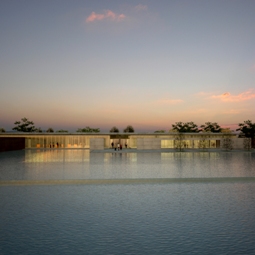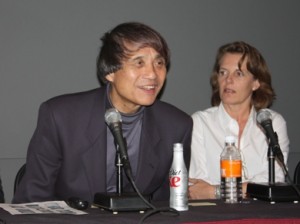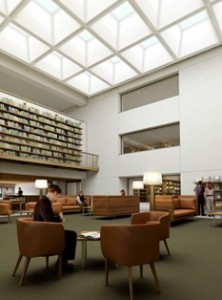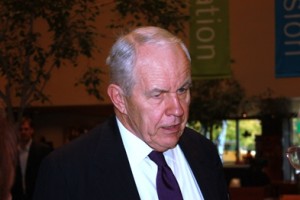by Seth Rogovoy
(WILLIAMSTOWN, Mass., October 17, 2011) – By summer 2014, a visit to the Sterling and Francine Clark Art Institute will be a substantially new and different experience than it is today.
While The Clark will remain one of the few institutions in the world with a dual mission as both a museum and leading international center for research and scholarship in the visual arts, and will continue to boast a world-class collection of more than 9,000 works containing exceptional European and American paintings and sculpture, extensive collections of master prints and drawings, English silver, and early photography, with a particular concentration in eighteenth- and nineteenth-century French art, including more than thirty paintings by Pierre-Auguste Renoir, as well as works by Claude Monet, Edgar Degas, and Camille Pissarro, The Clark will be reconfigured and expanded substantially to make for a more dynamic visitor experience that will take better advantage of and integrate The Clark’s unique immediate surroundings.
“The Clark is not just a place, but a place of mind … a greenhouse of ideas,” said museum director Michael Conforti in a press conference held at the institute on Monday. “My goal in my fifteen years here at The Clark has been to optimize the setting and enhance the visitor experience, and this particular expansion and renovation with reimagine the circulation and flow of the galleries and reorient the buildings on our campus vis a vis the vistas surrounding us.”
Conforti announced substantial completion of a major infrastructure project launched last year and the initiation of a $145 million in construction activities to continue work on the final phase of the campus expansion program. The project, which is estimated to create 500 new jobs during the construction phase, includes construction of a new 44,400-square-foot Visitor, Exhibition, and Conference Center designed by Pritzker Prize-winning architect Tadao Ando; renovation of the existing museum building and Manton Research Center by architect Annabelle Selldorf; and a sweeping new landscape design by Gary Hilderbrand that will reorient the visitor experience on the Clark’s 140-acre property to highlight its natural setting and enhance sustainability. The entire project is expected to be completed in summer 2014.
Once the expansion is complete and the museum opens anew, The Clark, already one of the region’s prime economic and tourist engines, will fuel an additional $9 million impact on the local economy.
During construction of the final phase of The Clark’s rehabilitation and expansion, which begins next month and is scheduled to conclude before summer 2014, a series of programs, called ClarkNOW, encompassing more than 60 projects over the next three years in Williamstown, New York, and around the globe, including exhibitions, installations, and academic programs, will take place.
In particular, The Clark will make use of the Explorer’s Club in New York City — originally home to Sterling Clark’s brother Stephen, and which Sterling Clark helped design – for exhibitions and programming.
“The coming years will be a period of great activity for the Clark,” said Conforti. “While our expansion program focuses on enhancing our built environment in Williamstown, ClarkNOW allows us to bring our collections and intellectual activities to U.S. and international audiences in new and exciting ways. We will continue to present the thoughtful and resonant exhibitions for which we have become known, deepen our relationship with our landscape and community in Williamstown, and extend our reach by engaging audiences through a mix of new programs presented in new places.”
Campus Expansion Program
The Clark’s final phase of its campus expansion program is now underway. A master plan developed by Cooper, Robertson & Partners, finalized in 2001, dramatically reconceived the entrance sequence to The Clark’s grounds and created a framework that allowed for physical expansion, improved circulation, and a dramatic embrace of The Clark’s extraordinary campus.
Tadao Ando Architect & Associates, Osaka, Japan, and landscape architects Reed Hilderbrand Associates, Watertown, Massachusetts, were selected to articulate the campus plan, which included pivotal decisions to remove the current maintenance building and relocate main parking areas in order to make way for significant landscape and architectural changes. Architect Annabelle Selldorf of Selldorf Architects, New York, was commissioned to renovate the original 1955 museum building and the Manton Research Center (built in 1973) in a way that would respect the original architecture, repurpose spaces to better serve both the museum and research and academic programs, and enhance the visitor experience.
The first phase of this plan was completed in 2008 with the opening of Stone Hill Center – designed by Tadao Ando – which created new gallery spaces, meeting rooms, an outdoor café with scenic mountain views, and a state-of-the-art facility for the Williamstown Art Conservation Center.
In summer 2010, work began on an infrastructure project that includes a new loading dock, food service and core mechanical facilities, and other support spaces. That project has now achieved substantial completion.
Highlights of the final phase of the campus expansion plan include:
Visitor, Exhibition, and Conference Center:
The stone, concrete, and glass Visitor, Exhibition, and Conference Center (VECC), designed by Tadao Ando, will serve as the new entry to The Clark. It will house special exhibition galleries, new conference facilities, dedicated spaces for family and community programming, and amenities including new visitor information, retail, and dining facilities. Features of the new building include: 10,500 square feet of galleries available for special exhibitions, nearly doubling the current space for temporary shows; a multi-purpose pavilion for conferences, lectures, and special events, as well as installations of works of art; and art transit facilities.
Ando said he views the VECC as a “transitional space, neither indoors nor outdoors.” Inspired by The Clark’s location, Ando said he was particularly sensitive to how “nature matched the wonderful art collection” at The Clark, “reaffirming the notion that art is food for the soul.”
The VECC will link to the original museum building through a light-filled glass entry pavilion that will create a new west-facing entrance to the 1955 structure, returning the building’s orientation to its original west-to-east axis. When complete, the project will seek a LEED Silver certification.
This VECC project has received $30 million in financing through bonds issued by MassDevelopment, the state of Massachusetts’s finance and development agency, which works with businesses, nonprofits, financial institutions, and communities to stimulate economic growth across the Commonwealth.
Museum Building
The first expansion and renovation of The Clark’s original museum building adds more than 5,400 square feet of new gallery space for the display of the Clark’s collections, a 45 percent increase. Architect Annabelle Selldorf’s sensitive reconfiguration of former office and storage areas into new galleries on two levels enables Tthe Clark to present more of its collection without disrupting the museum’s original atmosphere and scale. Enhancements to the museum building include: new galleries dedicated to European and American decorative arts; a new gallery for American art; a complete renovation of the original galleries; an orientation room focused on the Clark’s special site and mission; additional spaces for special installations of works of art; and improved lighting and climate control systems throughout the galleries.
Selldorf said that some of the “charm” of the original museum building, which was designed as a home for the Clarks as well as a public gallery, “may lie in its oddity.” The reconfiguration of the building’s gallery spaces and traffic flow is intended both to make it more “natural and logical” while at the same time to make it appear “as if nobody did anything to it,” largely by taking advantage of its original features and intentions.
Manton Research Center
Architect Annabelle Selldorf’s design for the renovation of the Manton Research Center reinforces the building’s purpose as the center for research and academic activities, while providing increased access to The Clark’s important collection of works on paper. Renovations to the Manton Research Center include the creation of a new Manton Study Center for Works on Paper, providing greater access to the Clark’s collection of prints, drawings, and photographs.
What visitors now think of as The Clark’s courtyard atrium will be a new public reading room, enhanced by a bookshop, information area, and coffee bar; and a new gallery for the exhibition of prints, drawings, and photographs. In addition, the project will include renovation of gallery space dedicated to the Manton Collection of British Art and technological upgrades to optimize The Clark’s auditorium for lectures, conferences, and performances.
Landscape
Reed Hilderbrand has worked with Tadao Ando to articulate a sweeping new landscape design for The Clark that balances visitor experience with environmental sustainability, enhancing the Clark’s campus in the process.
The unifying element of the landscape design is a tiered 1.5-acre reflecting pool that replaces current parking areas and unites the natural setting with surrounding buildings. The reflecting pool is also at the heart of a sophisticated water engineering program that significantly reduces the Institute’s impact on natural resources and underscores its commitment to stewardship of the land.
“Every time visitors come here there will always be a change of place,” said Ando, due to the effect the seasons and even the time of day will have on the reflecting pool, even to the point that it will transform into a skating rink when it freezes in the winter.
Key elements of the landscape design include: a new entrance drive reorienting visitors’ arrival on campus; an integrated water management system that reduces potable water usage on-site by 50 percent; two miles of new walking trails providing greater access to the meadows, woodlands, and seasonal streams on The Clark’s campus highlighted by interpretive trail markers noting geological features and conservation initiatives; substantial new plantings of native species, including more than 350 trees; and landscaped parking accommodating 340 vehicles.
Hilderbrand said he views The Clark itself as “a trailhead” and the reconfiguration of the campus as a comment on “what it’s like to be inside a landscape that is dramatic, historic and stunning every day of the year.”
Ando spoke passionately about how The Clark, in its setting, can offer “one of the most unique museum experiences in the world.” Showing off his pedometer, this inveterate walker said the design must encourage the blending of art and nature and encourage walking and exploring, so that “we should all live to be 100.”
ClarkNOW
Conforti emphasized that the museum will not close during what will undoubtedly be several years worth of construction and adjustment. The ClarkNOW program encompasses more than 60 exhibitions, installations, and academic programs presented in Williamstown, New York, and around the world. The Clark’s Williamstown campus will remain open throughout the expansion project, providing visitors with new presentations of its permanent collection and a series of special exhibitions and collaborations.
The first ClarkNOW exhibition, Rembrandt and Degas: Two Young Artists, will open in Williamstown on November 13. Co-organized with the Rijksmuseum, Amsterdam, the exhibition will for the first-time explore Rembrandt’s influence on Degas through the juxtaposition of youthful self-portraits by these two artists. The exhibition, which drew critical and public acclaim during its recent presentation at the Rijksmuseum, will make its U.S. debut at The Clark where it will be on view through February 5, 2012, before traveling to The Metropolitan Museum of Art in New York.
Conforti announced the opening of a Clark office in Manhattan at the Explorers Club – the former home of Sterling Clark’s brother Stephen, at 70th Street between Madison and Park avenues. The Explorers Club will be the site of the first ClarkNOW exhibition in New York, an installation by artist Mark Dion, which will open in spring 2012. Dion’s project, Phantoms of the Clark Expedition, is inspired by Sterling Clark’s scientific expedition through Northern China in 1908–09 and will be installed throughout the historic building. The exhibition will be open daily to the public with no admission fee.
“We eagerly anticipate Mark Dion’s installation at the Explorers Club,” Conforti said, “as it allows the public a contemporary view into a little-known part of our founder’s life story in a setting that is rich with a history that uniquely ties to the Clark family.”
Phantoms of the Clark Expedition also creates a connection to two exhibitions that will be presented on the Clark’s Williamstown campus in summer 2012 – Unearthed: Recent Archaeological Discoveries from Northern China (June 18–October 21, 2012), and Through Shên-Kan: Sterling Clark in China, 1908–09 (June 18–October 21, 2012).
Unearthed features significant works of ancient Chinese art, many of which have never before been seen outside China, while Through Shên-Kan will display historic artifacts and documents tied to the Clark expedition, including specimens collected during the scientific trek on loan from the Smithsonian Institution. The Clark has worked closely with China’s Ministry of Culture over the last several years as part of an on-going cultural exchange initiative. It is through these efforts that special permission has been granted to allow the archaeological objects to be presented at the Clark in commemoration of the 100th anniversary of the publication of Through Shên-Kan, the book written by Clark and naturalist Arthur de Carle Sowerby documenting the important scientific expedition.
International Tour
A key component of ClarkNOW is the Institute’s international tour of works from its noted collection of nineteenth-century French paintings. Conforti announced that the tour will continue to Japan in 2013 and will then travel on to venues in China and Korea. Tokyo’s Mitsubishi Ichigokan Museum will present the Clark exhibition from February 9 to May 26, 2013, followed by an exhibition at the Ando-designed Hyogo Prefectural Museum of Art in Kobe from June 8 to September 1, 2013.
“Our international tour has vastly exceeded our expectations in both critical and popular response,” Conforti said, noting that “our Renoir exhibition that opened at the Prado in Madrid in October 2010 drew 370,000 visitors over the course of 16 weeks, making it the fourth best-attended exhibition in the Prado’s history.” He said that the show is currently “setting new attendance records at the Musée des impressionnismes in Giverny, France, where it has already drawn more than 100,000 visitors.”
The international tour will close its run in Giverny on October 31 and will open at Barcelona’s CaixaForum on November 17. Venues in 2012 include: the Kimbell Art Museum, Fort Worth, Texas (March 11 – June 17, 2012); the Royal Academy of Arts, London (July 7 – September 23, 2012); and the Montreal Museum of Fine Arts (October 8, 2012 – January 20, 2013).
Other upcoming ClarkNOW programs include:
New York: A Clark Conversation between Princeton University’s Hal Foster, the winner of the 2010 Clark Prize for Excellence in Arts Writing, and Robert Slifkin, Assistant Professor of Art History at the Institute of Fine Arts at New York University. The discussion will be held at the Explorers Club, 46 E. 70th Street, New York at 6 pm on October 27. Admission is free, but reservations are required.
Williamstown: The 2011 Clark Conference, In the Wake of the Global Turn: Propositions for an “Exploded” Art History without Borders (November 4–5, 2011), a two-day conference examining the questions related to what a shift towards a broader geographical expanse in art historical inquiry has meant – and could mean – for the discipline.
Williamstown: Clark Remix (opening February 12, 2012), a new installation of more than 300 works from the Clark’s permanent collection of paintings, sculpture, and decorative arts in a “salon-style” presentation that will allow audiences to engage with the collection in new ways, both within the gallery and through a new interactive project called “uCurate” that will also be featured on the Clark’s website.
Sydney: The Research and Academic Program’s Clark/Mellon Initiative begins with a workshop related to issues focused on artistic exchange in the Indian Ocean region.
New York and Texas: Exhibitions of works from the Clark will be on loan at The Metropolitan Museum of Art, New York, and the Frick Collection, New York; the Amon Carter Museum in Fort Worth, Texas, in 2012 and 2013. A special exhibition of the Clark’s collection of works on paper will be presented.
The Clark will continue its major summer exhibitions in Williamstown, beginning with Unearthed in 2012 and a 2013 exhibition on Winslow Homer drawn from the Clark’s renowned holdings of the artist’s paintings, watercolors, prints, and drawings. In 2014, the Clark will inaugurate its new facility with a summer exhibition that “is one of the most important in the Institute’s history,” said Conforti. The exhibition, on loan from the collection of the Museo Nacional del Prado in Madrid will focus on the nude, drawing from the Prado’s esteemed holdings of works by masters including Titian, Rubens, and Velázquez.
The Sterling and Francine Clark Art Institute
The Clark is one of the few institutions in the world with a dual mission as both a museum and leading international center for research and scholarship in the visual arts. The Clark presents public and education programs and organizes groundbreaking exhibitions that advance new scholarship, and its research and academic program includes an international fellowship program and conferences. The Clark, together with Williams College, America’s foremost liberal arts college, sponsors one of the nation’s leading master’s programs in art history.
The Clark is located at 225 South Street in Williamstown, Massachusetts. The galleries are open Tuesday through Sunday, 10:00 am to 5:00 pm (daily in July and August). Admission is free through May. Admission is $15 June 1 through October. Admission is free for children 18 and younger, members, and students with valid ID. For more information, call 413 458 2303 or visit Sterling and Francine Clark Art Institute.





